
Disney’s Hollywood Studios is full of statues, but I suspect that most of you have only given these a cursory glance at most. And that’s understandable. How can a statue compare to an AudioAnimatronics figure or a real person? But there is some value to examining these sculptures and I hope to offer a little more information than the plaques that accompany some of them provide. Let’s start with the first one we encounter when entering the park, Mickey Mouse.
High above the Crossroads of the World building found on Hollywood Boulevard we find our intrepid leader of the club. Posed in a walking stance, Mickey welcomes everyone to Disney’s Hollywood Studios.
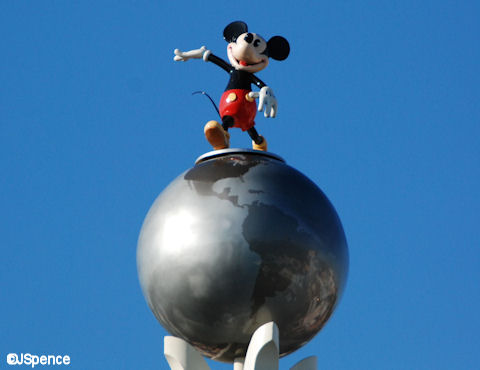
I could bore you with a lot of “Mickey” facts – like Mickey popped into Walt’s head while returning from New York on the train after losing his rights to Oswald the Lucky Rabbit. How Ub Iwerks took Walt’s ideas and turned them into reality in 1928. And how Walt wanted to name his new creation Mortimer but his wife Lillian nixed the idea and suggested Mickey. But you already know all that. So instead, I’m going to talk about the building Mickey uses as a base.

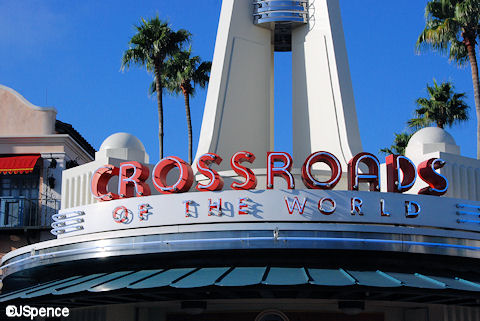
Most of the structures on Hollywood Boulevard are modeled after real buildings found in and around Los Angeles. (Technically, Hollywood is a district of LA, not its own city.) Some of the buildings at the Studio are almost carbon copies of the original, but you will always find differences as buildings can be copyrighted. Such is the case with the Crossroads of the World building.
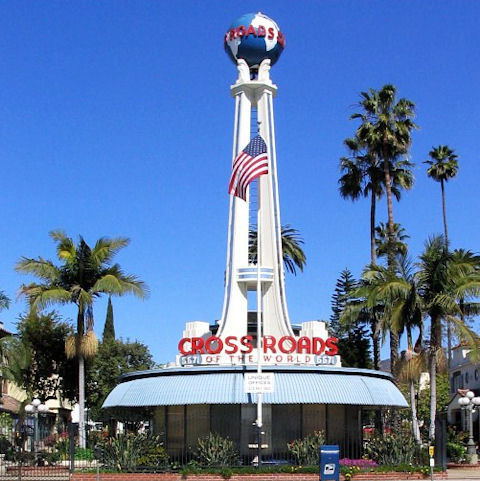
The original Crossroads of the World building is located at 6671 Sunset Boulevard. It opened to the public on October 29, 1936 and was typical of the imaginative architecture of the time.
Designed to resemble a ship, the Crossroads of the World building anchored LA’s first outdoor shopping mall. Behind it was a “village” of buildings, each with a distinct international architectural style. Some of these included French, Italian, Spanish, Moorish, California Mediterranean, and Cape Cod/Early American. The first floor of this village housed retail shops while the second story was rented out as office space.
Today the mall houses mostly offices for the entertainment industry. The Crossroads of the World building was added to the National Registry of Historic Places in 1980.
Although I said I wouldn’t be discussing this Mickey Mouse statue, I did want to add, the reproduction of him atop the Crossroads of the World building represents how he appeared in the 1930’s, the era of Disney’s Hollywood Boulevard.
Our second statue of an early movie director is accompanied by the Studio Dedication Plaque. It can be found at the end of Hollywood Boulevard. Let’s start with the plaque.
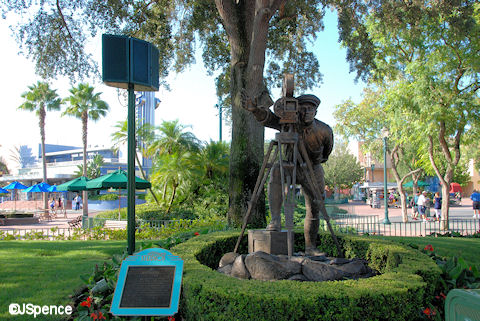
If you’ll notice, a frame was placed around the plaque in January 2008 to reflect the park’s new name (Disney’s Hollywood Studios). However, the old name (Disney-MGM Studios) is still visible on the plaque itself. This is probably one of the very few places left where guests can still see the park’s old logo.
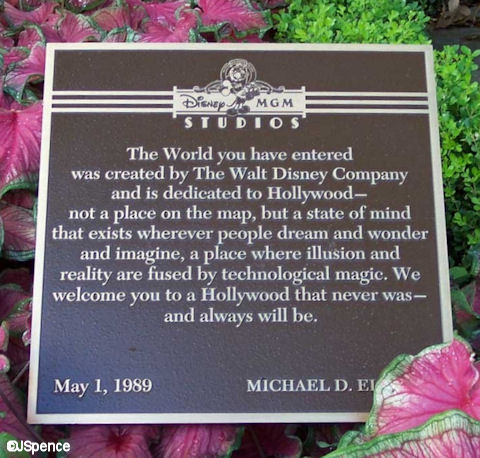
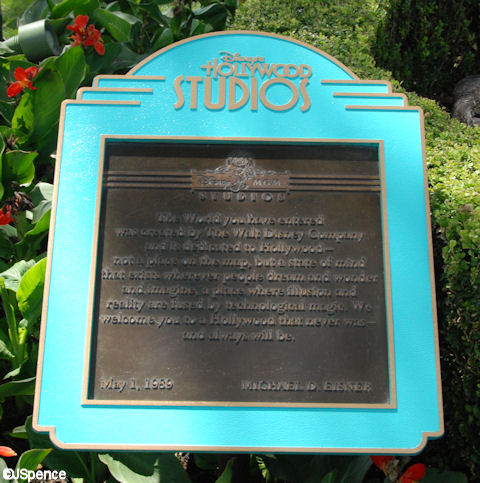
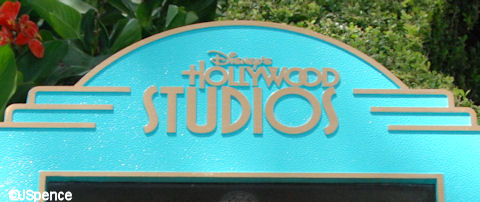

Next to the dedication plaque is a statue of a 1930’s movie director checking out his next scene through the viewing scope on his camera.

The camera depicted here is an early Technicolor 3-color machine first used in 1934. This camera used mirrors and a prism located behind the lens to reflect light onto three monochrome strips of film. Each strip was sensitive to one of the primary colors, red, green, and blue. Later, these exposed strips were merged to create a vibrant array of colors.
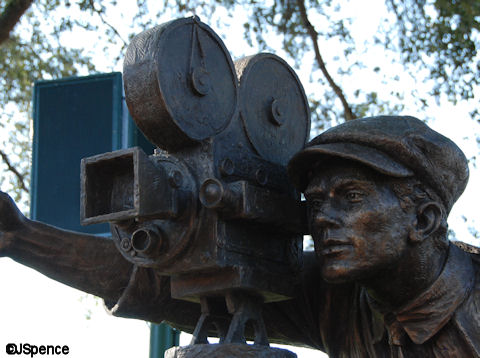

In 1929, Walt Disney started producing his Silly Symphony series of animated short subjects. These stories did not usually feature a continuing character (like Mickey Mouse) from one story to the next. Instead, a new group of characters were introduced with each consecutive film and the weak plot revolved around a musical score. However, the Silly Symphonies did not achieve the success of the Mickey Mouse series of cartoons.
In 1932, Walt was introduced to the new Technicolor “three-strip” process. He was so impressed that he negotiated an exclusive contract with Technicolor as the only animation company who could use the process until 1935. This forced competitors like Ub Iwerks (who had left Disney) and Fleischer Studios to continue using the older 2-color process until 1935 and they could not release any 3-color films until 1936.
“Flowers and Trees” was already 60% complete as a black & white short when Walt halted production and had it reanimated in color. This did the trick and breathed new life into the Silly Symphonies series. The series even eclipsed the Mickey Mouse cartoons for a while. A total of 75 Silly Symphony shorts were produced between 1929 and 1939.
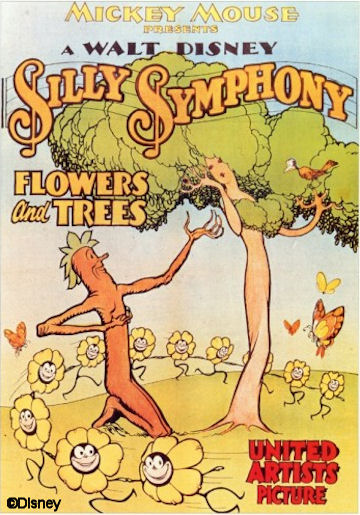
If you pay attention to Disney credits, the name “Technicolor” was always prominently displayed on older shorts and features.

This next statue was always one of my Studio favorites. Not because it had any real significance, but because I would play “Where in the World” with this photo. When I would ask friends where at Walt Disney World this statue could be found, they invariably guessed the Italy Pavilion at Epcot.

In reality, this statue is wedged in between the 50’s Prime Time Café and the Hollywood & Vine Restaurant in the Echo Lake section of the park.
When I visited the Studio recently to take pictures for this article, I found my lovely lady was missing. Let’s hope she’s just backstage getting a facelift.

I will also use the statue to shamelessly plug another feature of AllEars.net. Each Sunday in the Photo Blog section, Erin Blackwell features a “Where in the World“ photograph. I challenge you to try and figure out some of her brain teasers. I know the “World” pretty well and only get about 50% correct.
On the other side of Echo Lake is perhaps the largest collection of busts this side of the Haunted Mansion. Here we find the Academy of Television Arts & Sciences Hall of Fame Plaza.


Each year the Academy of Television Arts & Sciences selects individuals to be inducted into the Hall of Fame. These industry leaders are recognized for their outstanding contributions to the arts, sciences, and management of television. The first awards were presented in 1984 and celebrated the careers of Lucille Ball, Milton Berle, Paddy Chayefsky, Norman Lear, Edward R. Murrow, William S. Paley, and David Sarnoff.
Disney has chosen to pay tribute to a number of the winners with bronze busts. These include:
Desi Arnaz
Bea Arthur
Diahann Carroll
Dick Clark
Bill Cosby
Walt Disney
Andy Griffith
Angela Lansbury
Mary Tyler Moore
Bob Newhart
Mike Wallace
Barbara Walters
Betty White
Oprah Winfrey
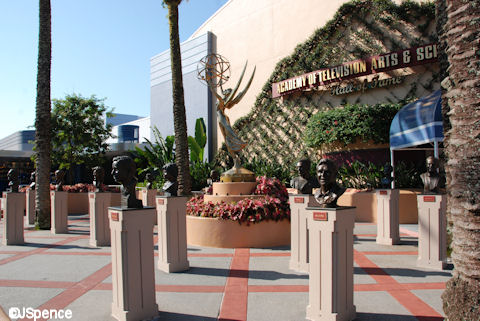
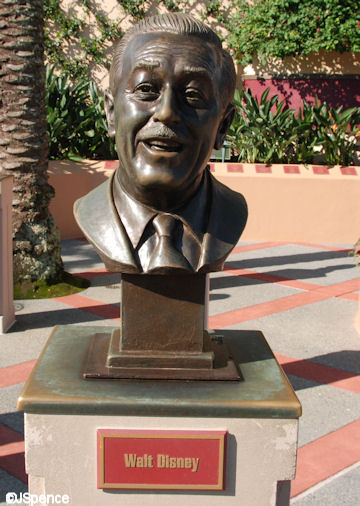
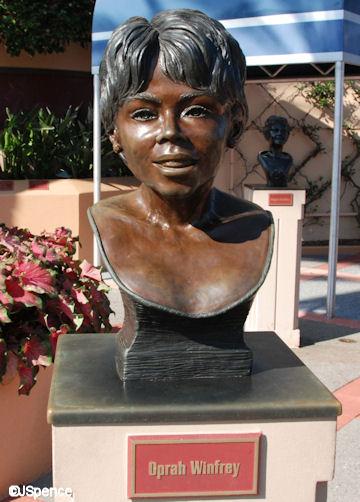
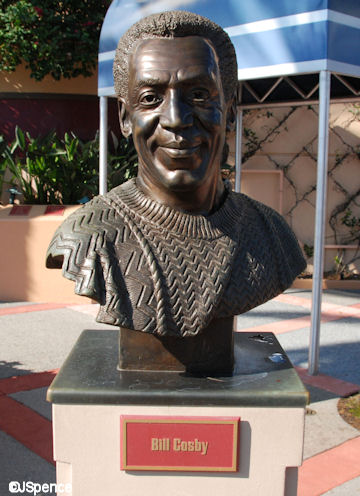
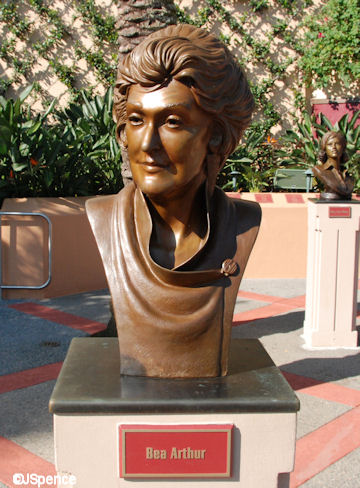
Along the back wall of the plaza, plaques displaying a complete list of each year’s winners can be found. Unfortunately, Disney has neglected to stay current and only presents the first 13 of the 20 award ceremonies conducted to date.
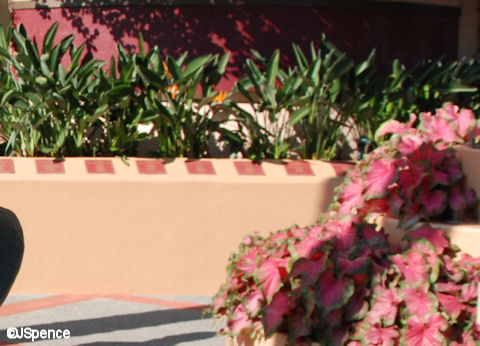
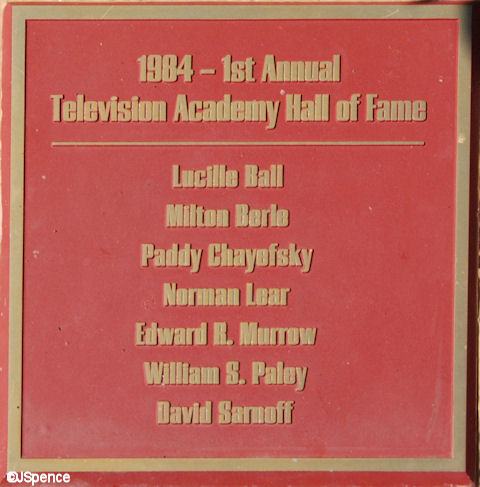
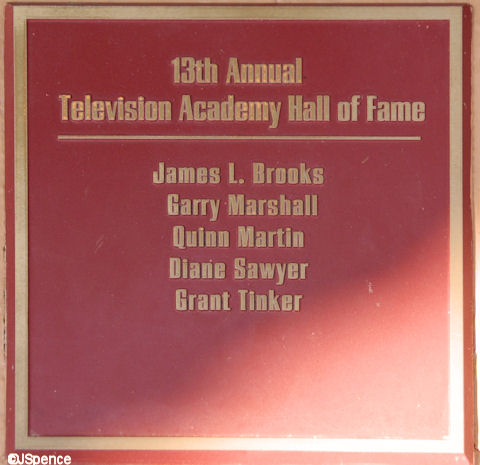
The centerpiece of this awards plaza is a statuette of the Emmy Award.
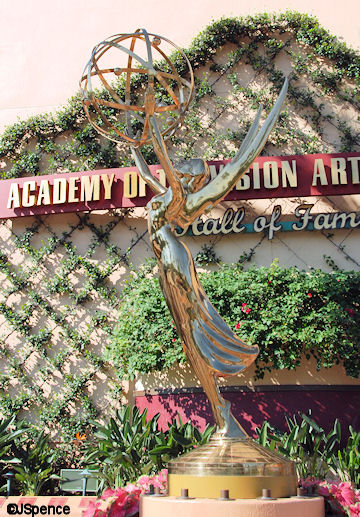
The Television Academy rejected 47 proposals for the Emmy statuette before selecting a design by television engineer Louis McManus in 1948. McManus used his wife as a model. The wings represent the muse of art; the atom the electron of science.
Academy founder Syd Cassyd suggested the name “Ike” for the statuette. This was a term used by television insiders for an iconoscope tube. However, this name was rejected as most people associated “Ike” with General Eisenhower. Eventually, the third academy president, Harry Lubcke proposed the name “Immy.” This was the term used for the image orthicon tube utilized in early television cameras. This name was selected, but later changed to “Emmy” to reflect the feminine nature of the statuette.
Each Primetime Emmy statuette weighs 6 pounds, 12½ ounces, and is made of nickel, silver, copper, and gold. Each takes 5½ hours to make and is handled with white gloves to prevent fingerprints.
Walt personally won 7 Emmy Awards.
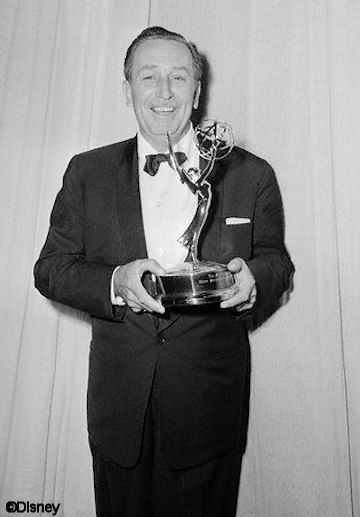
To learn more about the Academy of Television Arts & Sciences, click here.
Our next statue can be found in Animation Courtyard. Once again we find the leader of the club, only this time, he’s posing as his most famous character, the Sorcerer’s Apprentice from the movie “Fantasia.” You can almost see the water splashing around him and hear Paul Dukas’ music in your head.
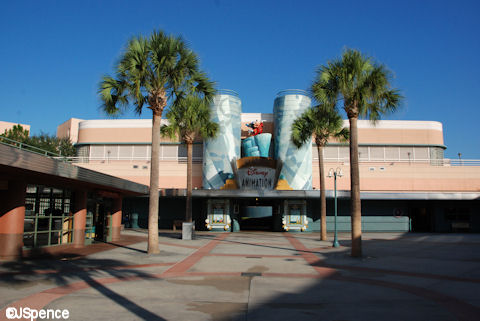
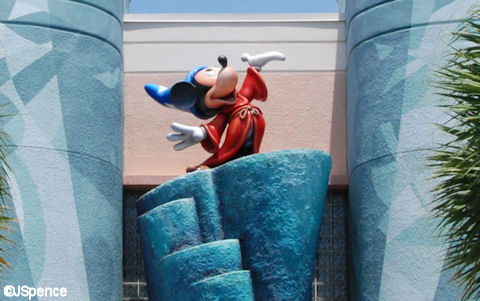
Again, I could provide you with all sorts of facts about the movie Fantasia – like it was the first commercial film to be shown in stereophonic sound. How it was meant to be re-released every few years with several segments removed and new ones taking their place. And how the movie received mixed reviews and failed to make a profit during its initial release. But you already know all that. So instead, I’m going to talk about the passageway Mickey stands above and where this path led guests in the early years of the park.
What is now the entrance to the Animation Tour was once the walkway that brought guests to the loading area for the Backstage Studio Tour. This was where you boarded the trams for a lengthy sightseeing trip behind the scenes of a “real” working movie studio. The statue of Sorcerer Mickey was nowhere to be found in those early years.
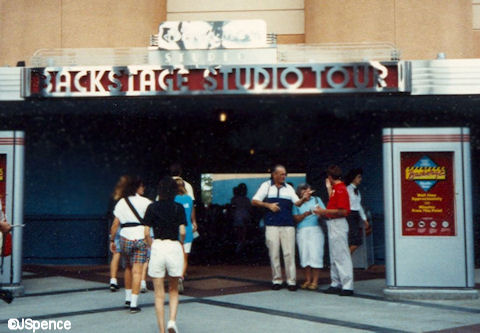

The Imagineers were far from innovative or original when envisioning a tram tour for the Disney-MGM Studios. Universal Studios in Hollywood (actually, Universal City), had been giving tram tours since July 15, 1964. Guests would begin the tour at Universal by visiting a few of the dressing rooms used by actual movie stars before boarding the tram. Then they would proceed to the Universal backlot and travel through a multitude of real movie sets that had actually been used in hundreds of movies. After disembarking, guests could purchase a bite to eat and leave. Universal Studios Hollywood never set out to be a theme park with rides and attractions. This evolved over time.
The trams used by Disney were extremely similar to those used by Universal – as was the concept for the tour. In the early years of the Disney-MGM Studios, guests would visit Residential Street and see the Golden Girls house, the Empty Nest house, and Herbie the Love Bug before proceeding on to Catastrophe Canyon.
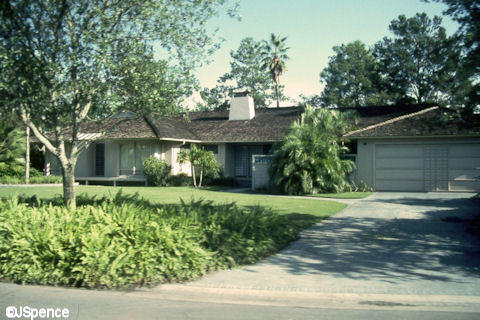
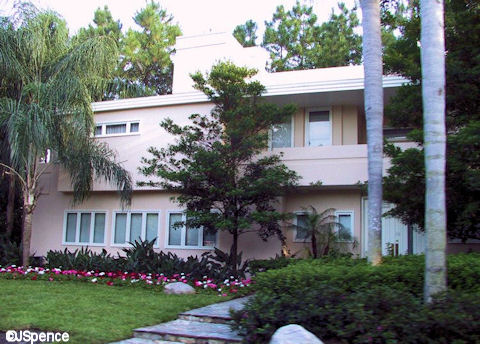
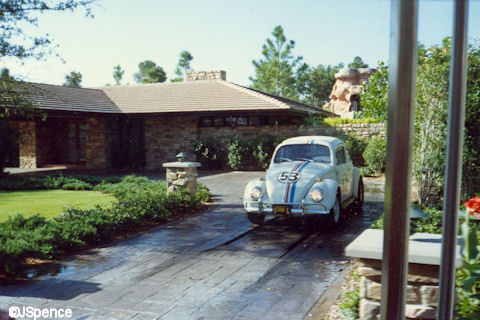
It’s interesting to note, the Golden Girls premiered on September 14, 1985. The Disney-MGM Studios didn’t open until May 1, 1989. Although Disney may have filmed one or two exterior shots of the house in Florida for the TV series, the home used in the vast majority of exterior shots was located in Brentwood, California and filmed in mass at the beginning of the series. The tram tour conveniently left this fact out and insinuated that this was THE Golden Girls house.
Another difference in the tram tour of the early years was New York Street (now Streets of America). This area of the park was not open to the public and the tram actually drove up and down this section of the back-lot.


When Universal Studios Florida opened, they did not feature a tram tour. However, guests expected one as its sister park in California had a tram tour as did its Disney neighbor. So management threw together a tram tour that took guests up and down the same streets that were already open to the public. It was a lame attraction and didn’t last long.
For you aficionados of Universal Studios Florida, I would like to make a recommendation. If you’re ever in California to visit Disneyland, put aside a day to visit Universal Studios Hollywood. Although the Florida and Hollywood studios share a few attractions, the experience is entirely different. For one thing, it is a REAL working studio chalked full of REAL movie history.
When the Disney-MGM Studios was being planned and built, Disney truly intended that it too would be a real, working studio where movies and television shows could be filmed and taped. One small aspect of this can be seen on a building found on the Streets of America. The structure currently labeled “Public Library” is a very official looking edifice that could pass for any public, local, state, or federal building.
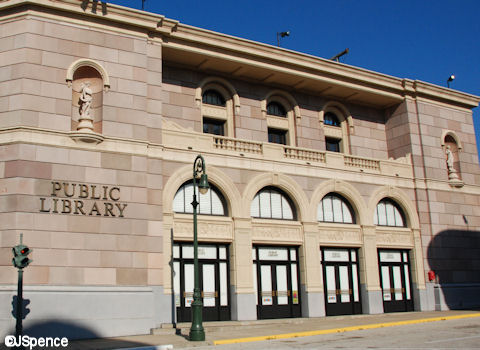
When examining the two statues found on the upper story of this building, we see they have a very formal and dignified look. However, they lack any real topic or theme. This lack of purpose was created intentionally. This would allow set designers to alter the function of the building simply by changing the lettering on the structure. This “Public Library” could just as easily pass as a City Hall or University. But if the statues were given a real persona, like Lady Justice, the building would be locked into the function of law.
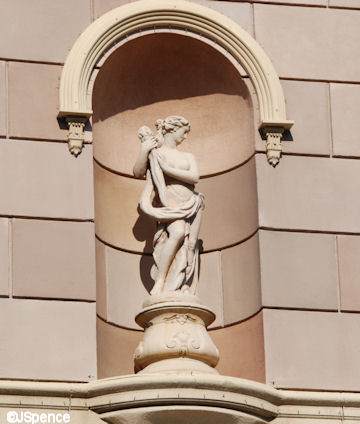
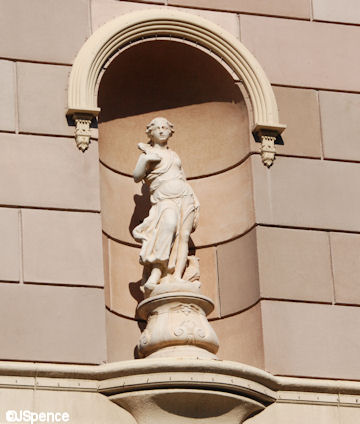
Probably everyone’s favorite statue at Disney’s Hollywood Studios can be found in front of Muppet*Vision 3D.
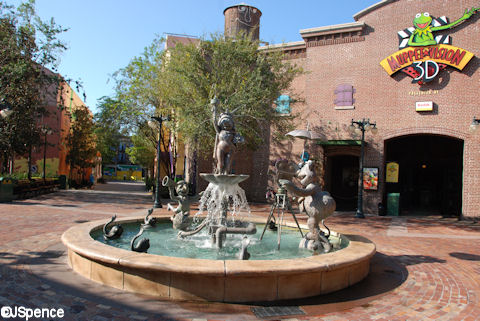
There really isn’t a lot to say about this fountain/statue. It’s pretty self-explanatory. In the center we have Miss Piggy in all her illustrious glory, recreating her role as Miss Liberty as seen in the nearby theater. To one side of the fountain we have Gonzo the Great directing the shot. On the other side we find Fozzie Bear as the cameraman. And finally, Animal working the plumbing. All of them are surrounded by spouting fish.
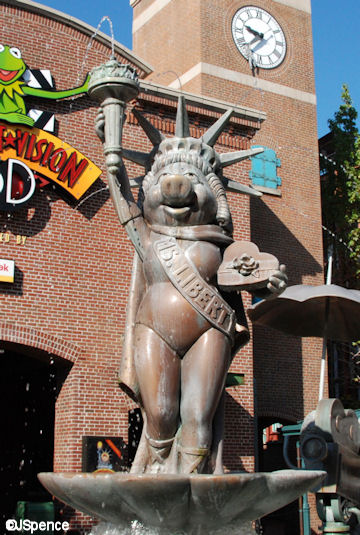
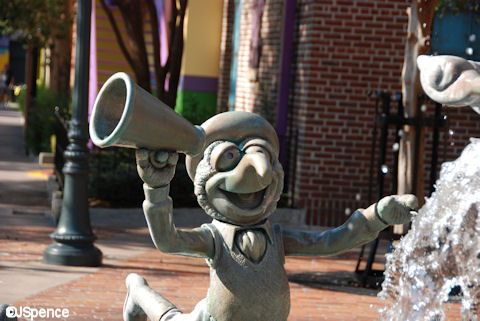
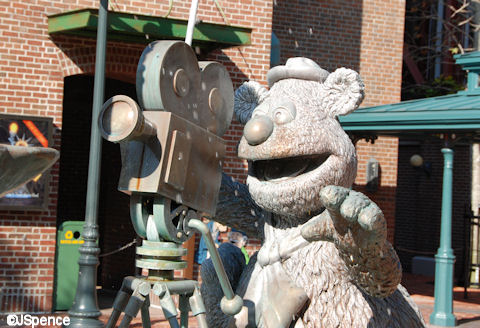
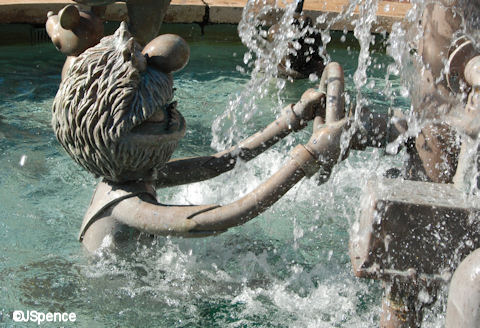

The Walt Disney Company bought the bulk of the Muppet characters and the Bear in the Big Blue House in 2004 for an undisclosed price. However, Disney does not own the characters appearing on Sesame Street or the Fraggles of Fraggle Rock.
The Muppet fountain is a fantastic photo op. During busier times, people must take turns capturing their friends and family posing with everyone’s favorite swine.
The last statue I’ll be discussing today can be found near the Studio Catering Co.


This sculpture was used in the movie “Splash” (1984) starring Tom Hanks, Daryl Hannah and directed by Ron Howard. This Mermaid Fountain was Madison’s gift to Allen. Although it appears to be made of brass and stone, it was fabricated entirely out of fiberglass at the Walt Disney Studios Scenic Shop. The molds used to produce the mermaid and dolphins were originally created for ice sculptures seen in the Disney movie, “Herbie Goes Bananas.”
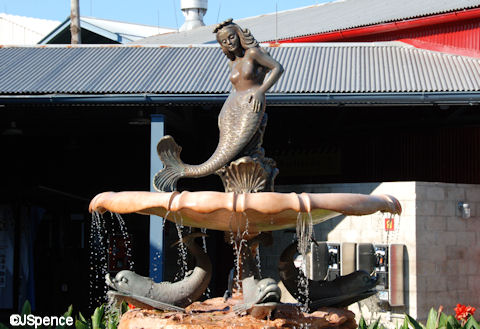
“Splash” contained language and brief nudity which was deemed inappropriate for a Disney movie at the time. This prompted the creation of Touchstone Pictures, a film label geared to a more mature audience. “Splash” also marked a milestone for Tom Hanks as this was the first movie in which he received top billing.
That’s it for Studio Statues. I hope you enjoyed this look at these many sculptures and the side trips I took along the way.




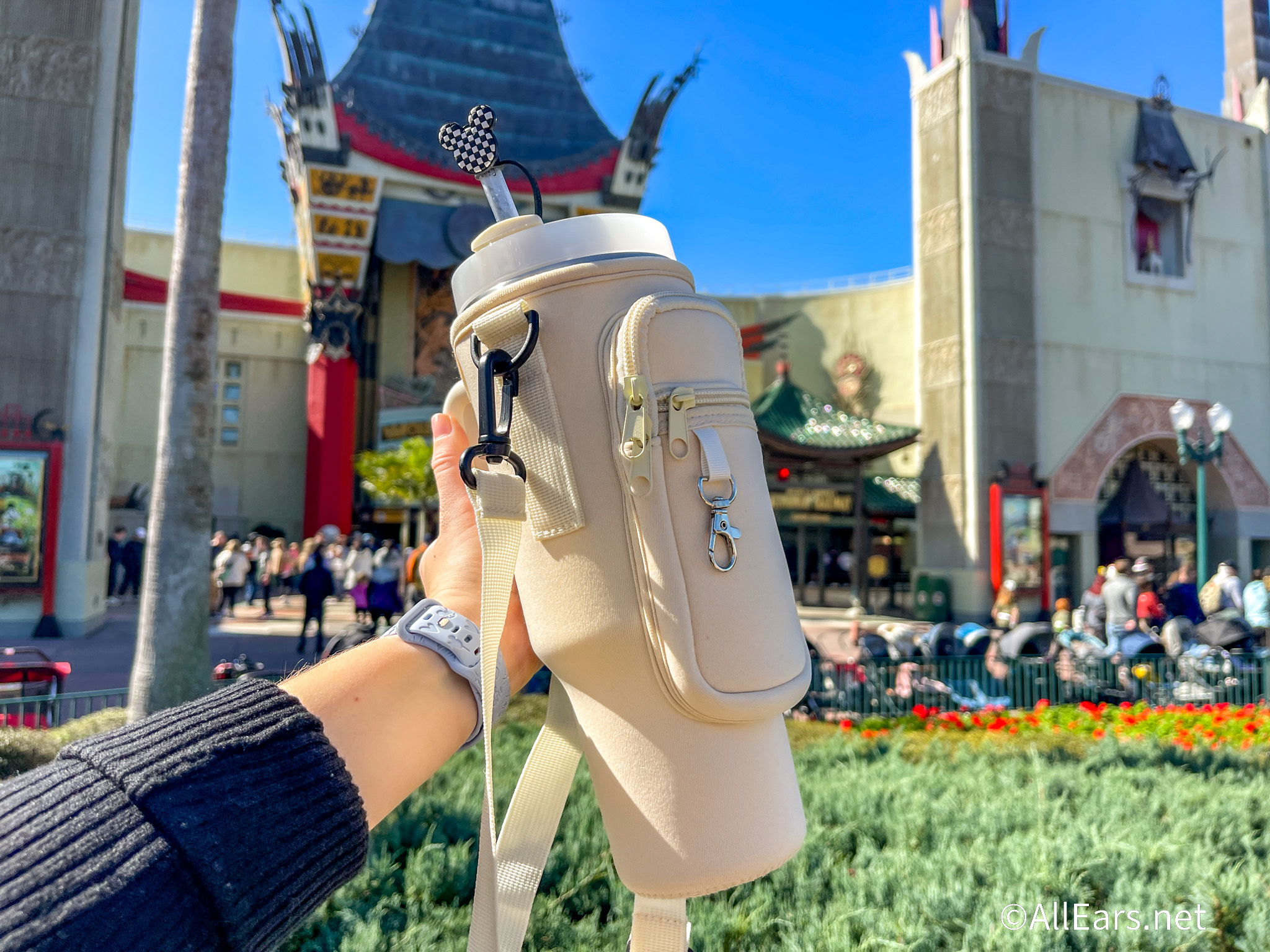
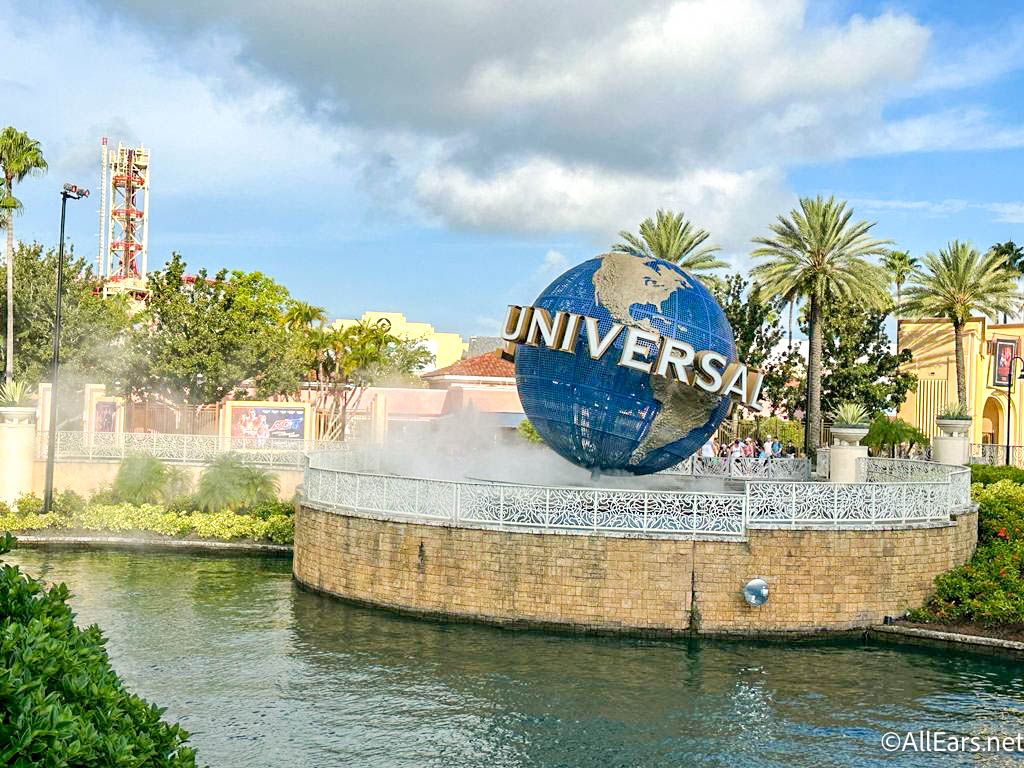

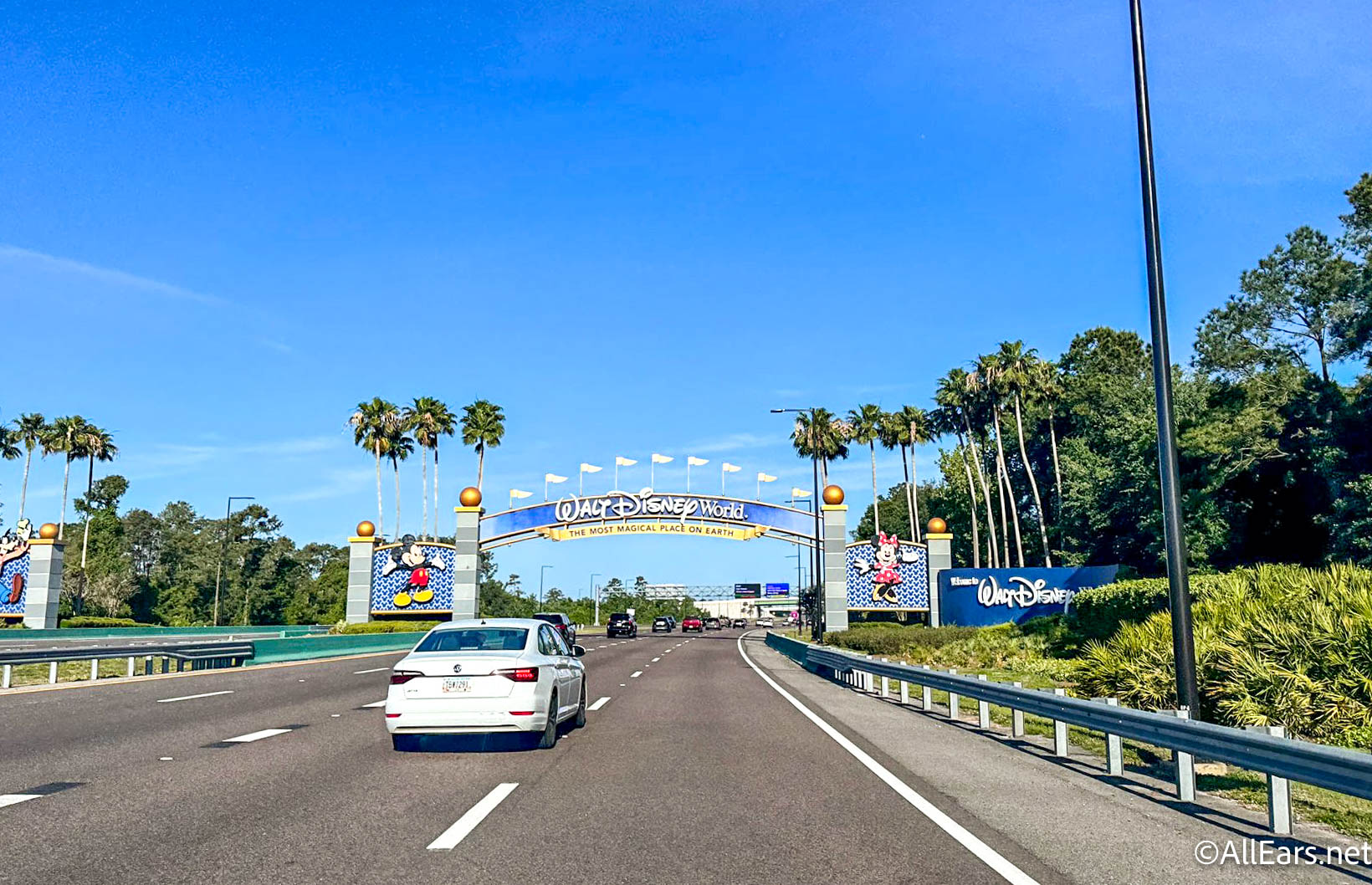



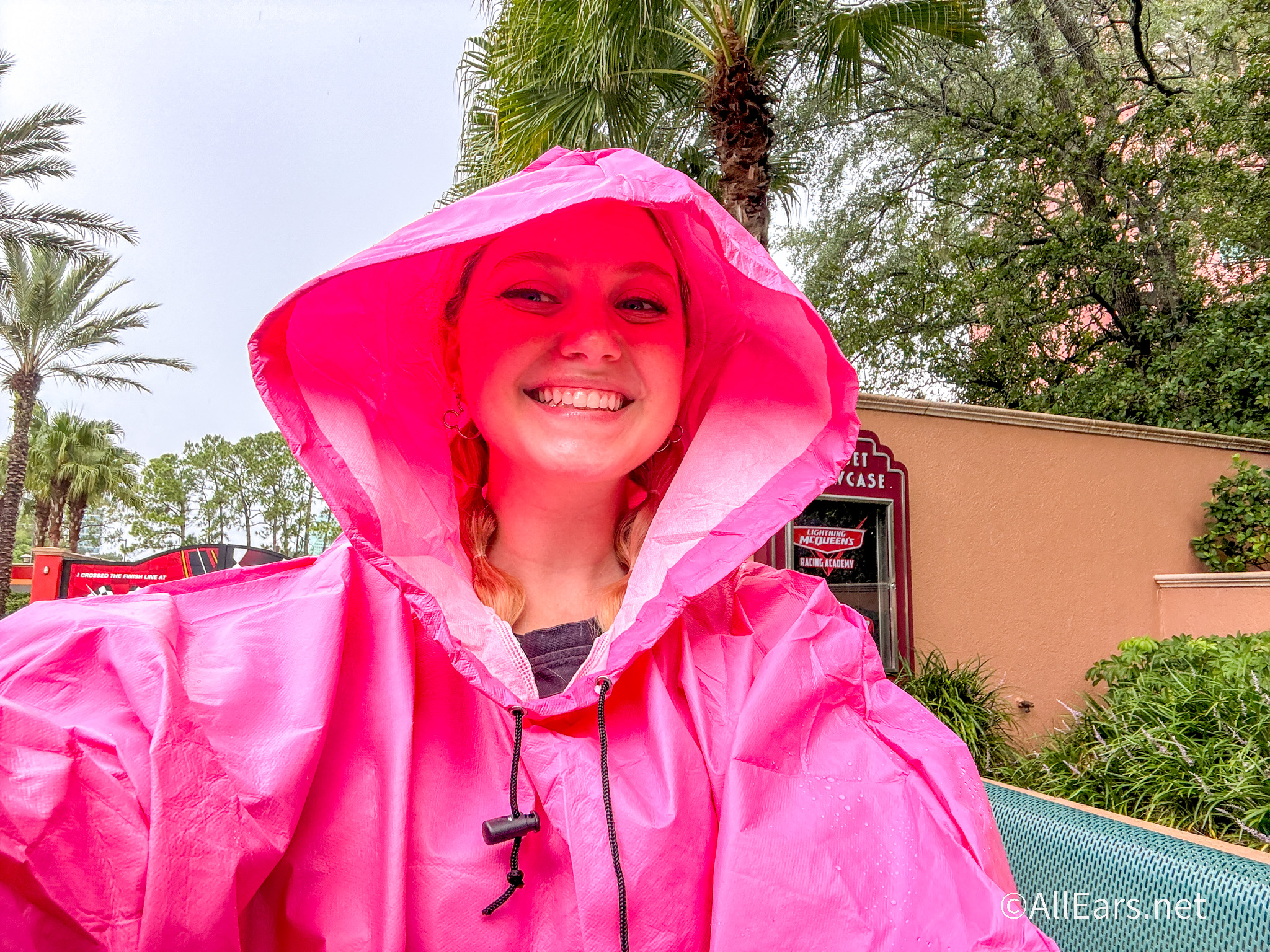
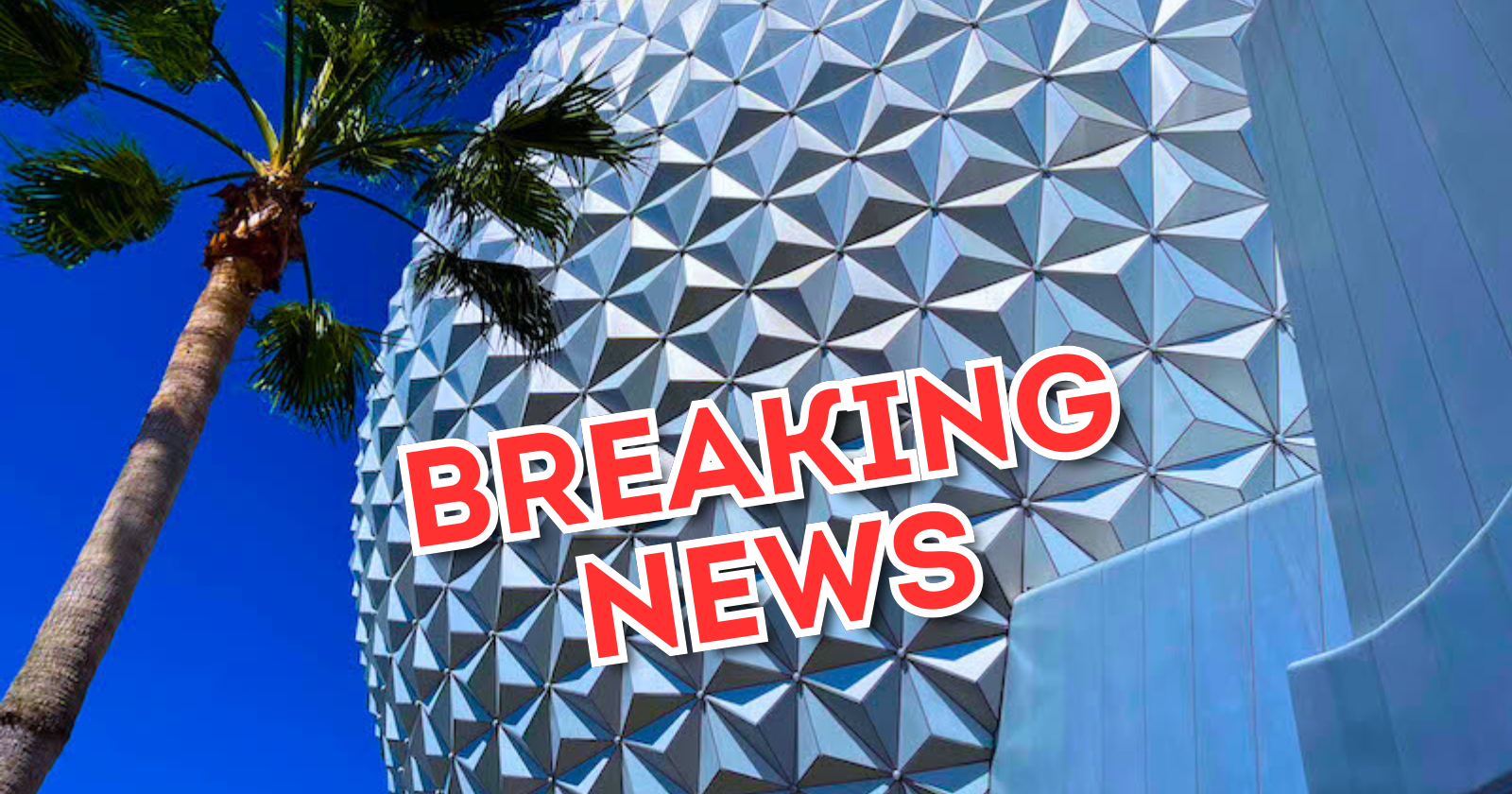


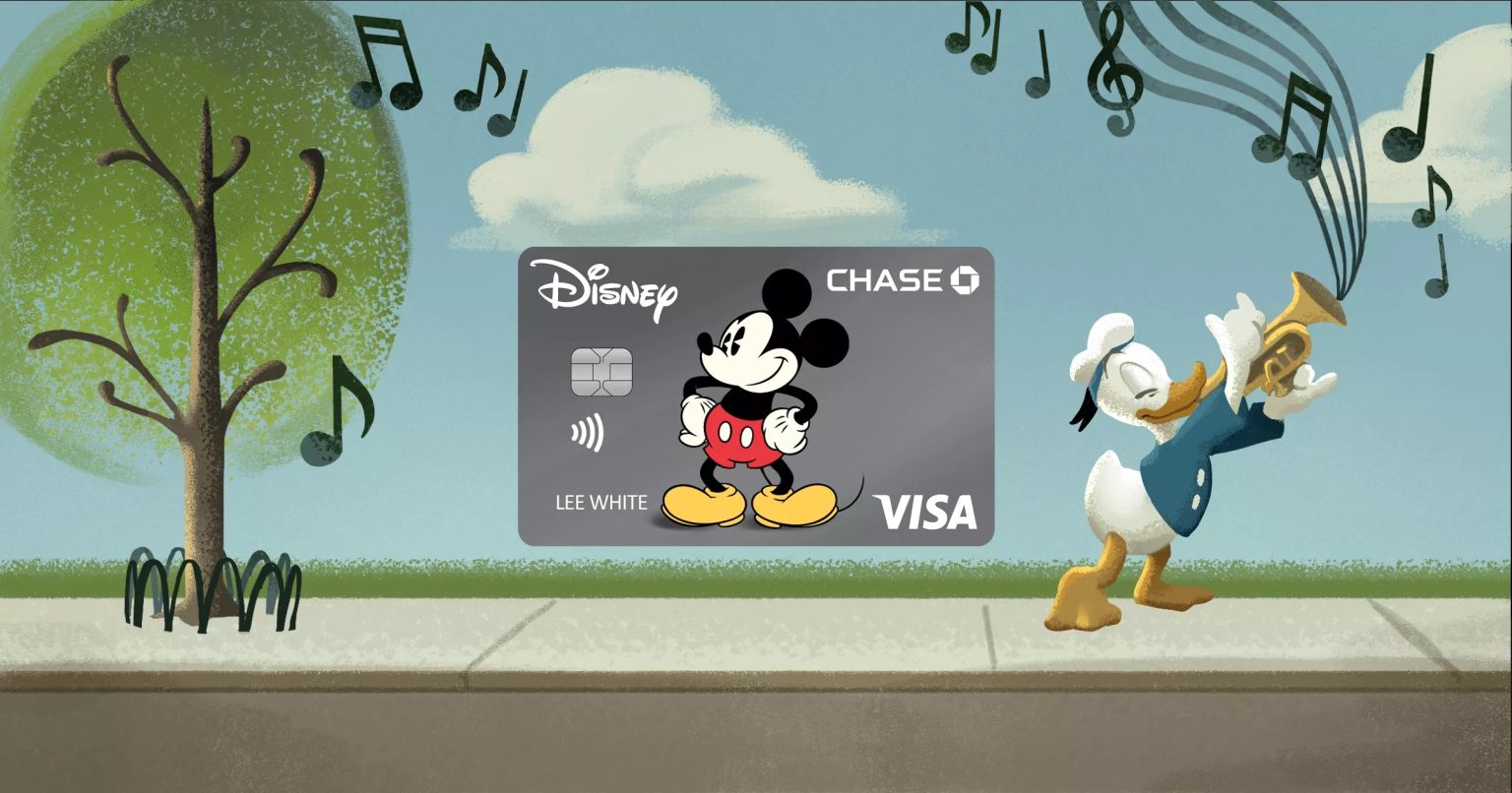



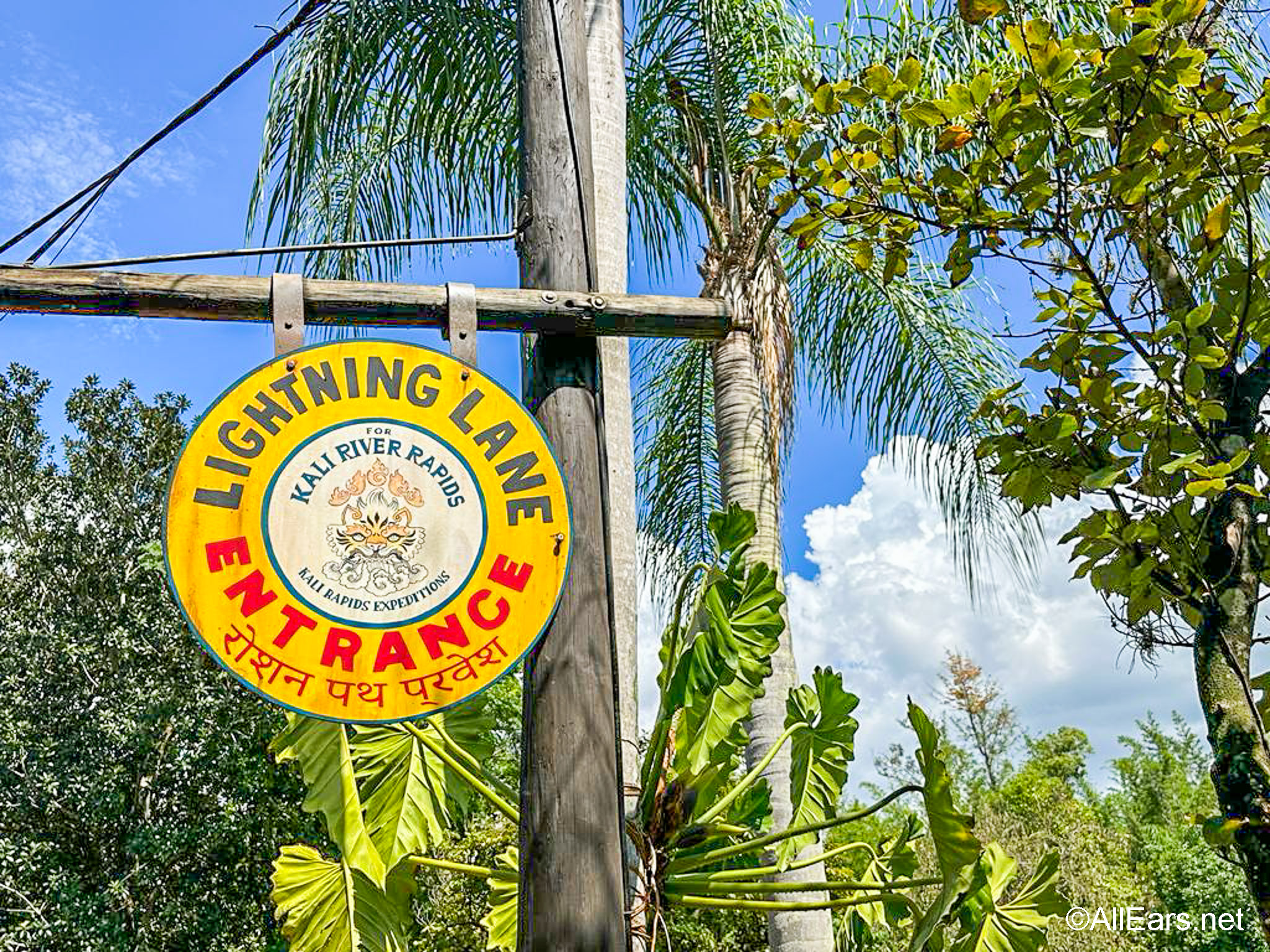
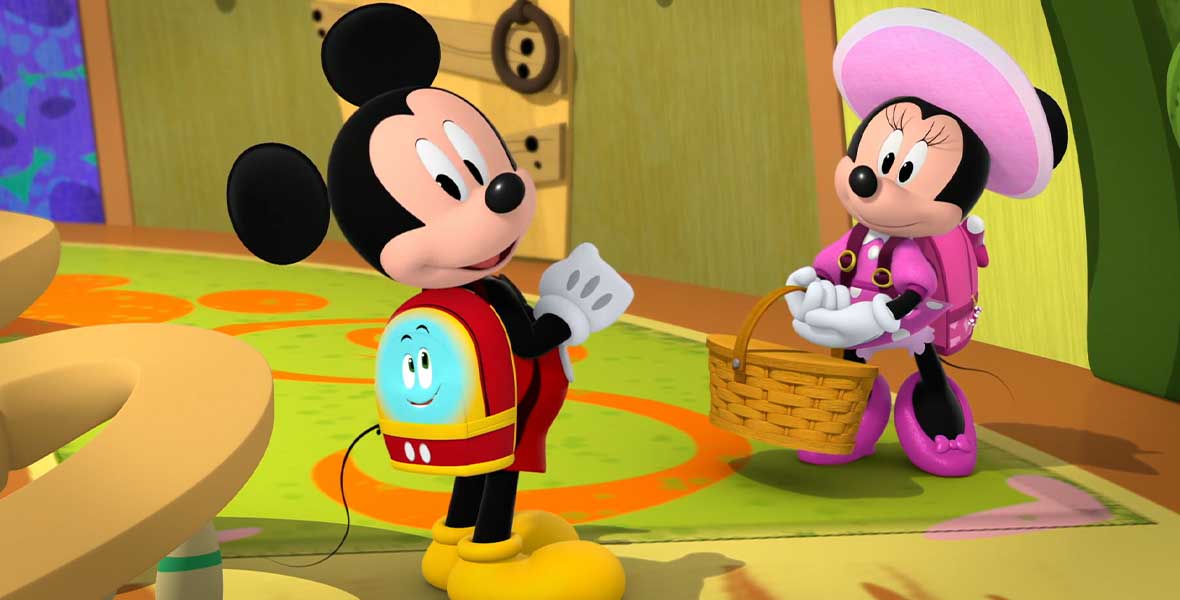

Hey Jack,
Thanks again for another great Blog. Thanks for the heads up on the Mermaid statue. I have passed by it multiple times and never stopped to really check it out. Its a must do now for one of my next trips. Herbie is one of my all time favorites and if I recall this is the ice sculptures in the cruise ship dining room scenes. I never realized this until you pointed it out!! Thanks!
Rob
Last summer, my family had an opportunity to visit Southern California. Knowing that it might be many years before we visit again, we made a point of seeing all of the real “touristy” stuff- including Disneyland and Universal Studios.
You nailed it when you said that the Universal Studios tram tour is of a REAL studio. I never was a REAL fan of the Disney Backlot tour, and after going to Universal California, I know why. The Disney version always seemed to be missing something to me, it just never seemed authentic. By the way, if you haven’t been to California in a while, the tram tour now includes a video narration by Jimmy Fallon, intermingled with the spiel of the on-tram host. I really enjoyed it.
Jack
thank you for a wonderful post – this really is one of your best among so many ‘best’ . Gosh , I know life moves on as it should in the Parks but I do miss the magic of the old backstage tour and the walking section where my Son was filmed on the bee when he was 5 . I do like the old MGM bits left over – we first visited 3 months after MGM opened in 1989 and I’m back again this coming spring . Thanks so much for making the magic even more magical
Mike
Nice report on the Studios, Jack. Does it ever annoy you how much Hollywood Studios and California Adventure are starting to look alike? If they add Cars Land in Florida the two parks will be like carbon-copy cousins and lose all of their individuality. 🙁
Jack’s Answer:
Even if they do add Cars Land to Hollywood Studios (and I hope they do), the two parks are very different in many ways.
I’ve never really had a problem with Disney duplicating attractions at the Disneyland Resort and at Walt Disney World. For the most part, the two resorts play to different audiences. However, I always hope they will make the attractions somewhat different from one another so Disney geeks like myself can spot the differences. Like Tower of Terror.
It does bother me when Disney brought Soarin’ over California to Epcot. A movie about California does not belong in this park. They need to film a new movie — Soarin’ over the World Showcase countries.
Hi Jack,
Wonderful blog as usual. It reminded me of the Osborne lights when they used to decorate the houses shown on the old Backlot Tour – seems like eons ago.
Wendy
Awesome piece of work Jack. I did not think that statues would be that interesting but this blog was extremely interesting! Great job!
“The Disney Fanatic”
Hi Jack –
I was lucky enough to have taken the complete (minus NY Street as it was open by then) Backstage Tram & Tour back in 1993, 1994 & 1995! The blue screen room, the soundstages, the editing areas and offices, and especially Bette Midler’s “The Lottery” short and how it was made, was an enjoyable and educational experience, the whole 1-1/2 to 2 hours of it.
I must also be blind – in all my trips to the Studios and for as many times as I’ve passed and photographed it, I have never noticed Animal playing with the pipes in the Muppet Fountain.
Thanks for making my Monday evenings a wonderful learning experience.
– Jeff
Hey Jack,
Since when have Mickey facts been boring? Bring ’em on! 😉 As always, great blog!
Aww, the Backlot Tour was so much better when they had the houses :'( I am glad that Streets of America is open to walk around in, though. Always have so much fun in that area pretending we’re really there 🙂
Hello Jack
I really enjoyed reading this blog and only wish I’d visited WDW before they changed the Backlot Tour. I love wandering down Streets of America but I would have loved to ride a tram through them. Never mind, I’ll just have to make do lol!
Thank you for another interesting blog.
Heather
The Muppet fountain also brings to mind Miss Piggy’s water ballet dream sequence from The Great Muppet Caper.
Yet another fun and interesting blog Jack.
And nary a typo in sight. Well done! I enjoyed it.
Your Friend,
Dan
Hi Jack,
As always I thoroughly enjoyed reading this article. Thank you.
By far my favorite statue at MGM is, and has always been, the “Movie Director” statue.
For me, it represents what the park was originally intended to be. I long for the days when MGM was closer to being a “working studio.” Does EVERYTHING always have to be coasters and thrill rides?
Thanks again. ~ See Ya’ Real Soon!
Johnny
hey Jack
I love lokking at these statues whenever I visit. It is good to slow down from the hustle and bustle once in a while and enjoy reading the plaques and looking at the different statues that the parks have to offer. I think my favorite in Hollywood Studios is the Muppet fountain. can’t wait for your next blog and as always keep up the great work.
Hi Jack! You’re right, by far, my favorite statue at DHS is the Muppet’s fountain. It’s such a fun piece!